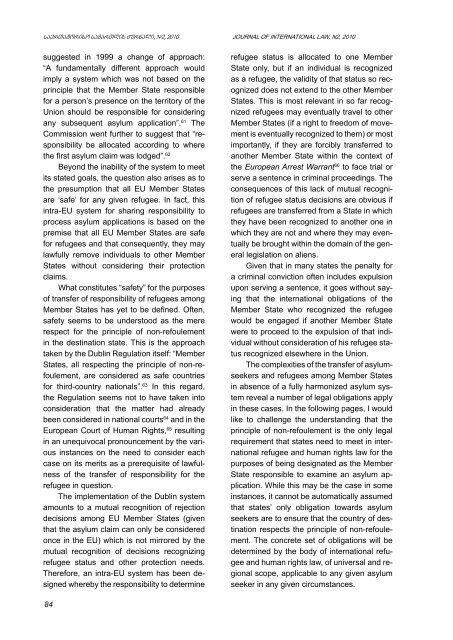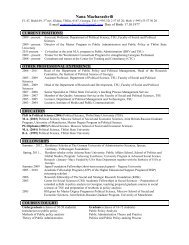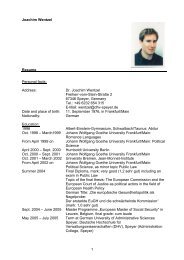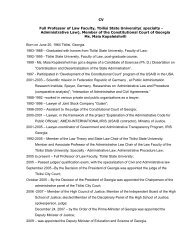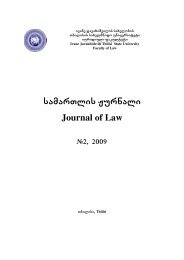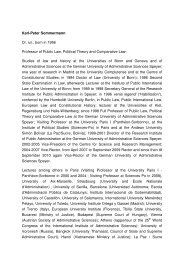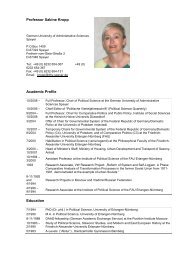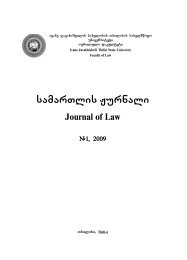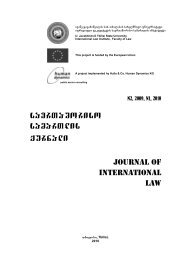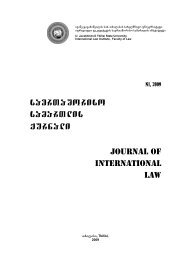Journal International Law_N2-10.indd
Journal International Law_N2-10.indd
Journal International Law_N2-10.indd
You also want an ePaper? Increase the reach of your titles
YUMPU automatically turns print PDFs into web optimized ePapers that Google loves.
saerTaSoriso samarTlis Jurnali, #2, 2010 JOURNAL OF INTERNATIONAL LAW, <strong>N2</strong>, 2010suggested in 1999 a change of approach:“A fundamentally different approach wouldimply a system which was not based on theprinciple that the Member State responsiblefor a person’s presence on the territory of theUnion should be responsible for consideringany subsequent asylum application”. 61 TheCommission went further to suggest that “responsibilitybe allocated according to wherethe fi rst asylum claim was lodged”. 62Beyond the inability of the system to meetits stated goals, the question also arises as tothe presumption that all EU Member Statesare ‘safe’ for any given refugee. In fact, thisintra-EU system for sharing responsibility toprocess asylum applications is based on thepremise that all EU Member States are safefor refugees and that consequently, they maylawfully remove individuals to other MemberStates without considering their protectionclaims.What constitutes “safety” for the purposesof transfer of responsibility of refugees amongMember States has yet to be defi ned. Often,safety seems to be understood as the mererespect for the principle of non-refoulementin the destination state. This is the approachtaken by the Dublin Regulation itself: “MemberStates, all respecting the principle of non-refoulement,are considered as safe countriesfor third-country nationals”. 63 In this regard,the Regulation seems not to have taken intoconsideration that the matter had alreadybeen considered in national courts 64 and in theEuropean Court of Human Rights, 65 resultingin an unequivocal pronouncement by the variousinstances on the need to consider eachcase on its merits as a prerequisite of lawfulnessof the transfer of responsibility for therefugee in question.The implementation of the Dublin systemamounts to a mutual recognition of rejectiondecisions among EU Member States (giventhat the asylum claim can only be consideredonce in the EU) which is not mirrored by themutual recognition of decisions recognizingrefugee status and other protection needs.Therefore, an intra-EU system has been designedwhereby the responsibility to determinerefugee status is allocated to one MemberState only, but if an individual is recognizedas a refugee, the validity of that status so recognizeddoes not extend to the other MemberStates. This is most relevant in so far recognizedrefugees may eventually travel to otherMember States (if a right to freedom of movementis eventually recognized to them) or mostimportantly, if they are forcibly transferred toanother Member State within the context ofthe European Arrest Warrant 66 to face trial orserve a sentence in criminal proceedings. Theconsequences of this lack of mutual recognitionof refugee status decisions are obvious ifrefugees are transferred from a State in whichthey have been recognized to another one inwhich they are not and where they may eventuallybe brought within the domain of the generallegislation on aliens.Given that in many states the penalty fora criminal conviction often includes expulsionupon serving a sentence, it goes without sayingthat the international obligations of theMember State who recognized the refugeewould be engaged if another Member Statewere to proceed to the expulsion of that individualwithout consideration of his refugee statusrecognized elsewhere in the Union.The complexities of the transfer of asylumseekersand refugees among Member Statesin absence of a fully harmonized asylum systemreveal a number of legal obligations applyin these cases. In the following pages, I wouldlike to challenge the understanding that theprinciple of non-refoulement is the only legalrequirement that states need to meet in internationalrefugee and human rights law for thepurposes of being designated as the MemberState responsible to examine an asylum application.While this may be the case in someinstances, it cannot be automatically assumedthat states’ only obligation towards asylumseekers are to ensure that the country of destinationrespects the principle of non-refoulement.The concrete set of obligations will bedetermined by the body of international refugeeand human rights law, of universal and regionalscope, applicable to any given asylumseeker in any given circumstances.84


